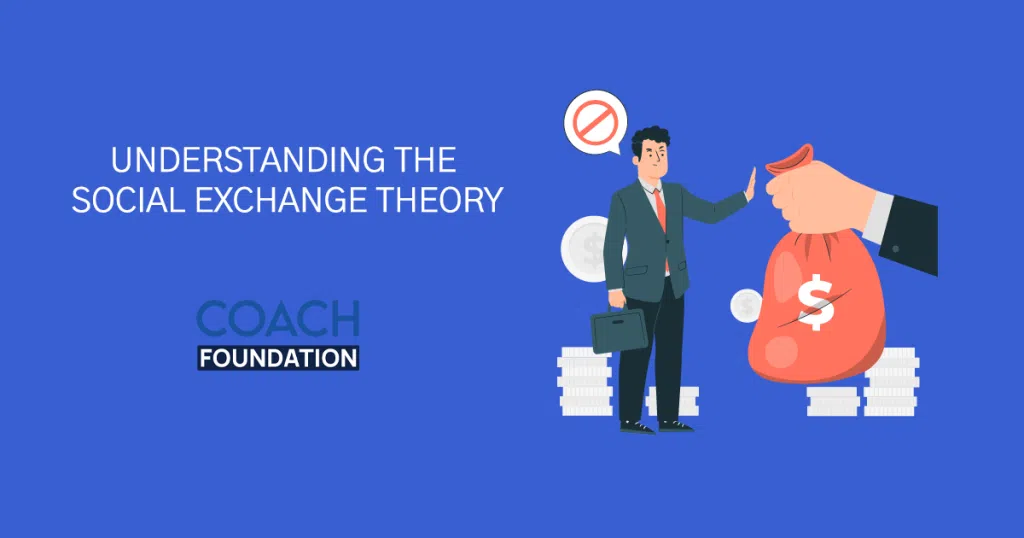Blog » Coaching Models and Techniques » The Social Exchange and Social Support model
Understanding The Social Exchange Theory
Social Exchange Theory is a social psychological perspective that seeks to explain human behavior in terms of cost-benefit analyses. According to this theory, people engage in social interactions with the expectation of receiving rewards and minimizing costs. Rewards can include anything from material goods to emotional satisfaction, while costs can include time, effort, and emotional strain.

Social Exchange Theory proposes that people evaluate the outcomes of their interactions and adjust their behavior accordingly, seeking to maximize rewards and minimize costs. This theory has been applied to a variety of contexts, from interpersonal relationships to organizational behavior, and can provide insight into how people make decisions and form social connections.
In this blog, we’ll explore:
1. What is the social exchange theory
2. How does social exchange theory work
3. Core Concepts of social exchange theory
4. Application of social exchange theory to life coaching
So, let’s get started!
What is the Social exchange theory
Social Exchange Theory is a social psychological perspective that seeks to explain human behavior in terms of cost-benefit analyses.
According to this theory, people engage in social interactions with the expectation of receiving rewards and minimizing costs. Rewards can include anything from material goods to emotional satisfaction, while costs can include time, effort, and emotional strain.
The theory proposes that people evaluate the outcomes of their interactions and adjust their behavior accordingly, seeking to maximize rewards and minimize costs. The decision to engage in a particular social interaction is based on a comparison of the expected outcomes with the costs associated with it.
For example, a person may choose to attend a social event because they expect to have a good time and enjoy socializing with friends, despite the cost of time and effort required to attend.
Social Exchange Theory can provide insight into a variety of social phenomena, such as interpersonal relationships, organizational behavior, and economic decision-making. It has been used to explain why people stay in abusive relationships, why employees choose to stay with or leave their jobs, and why individuals may choose to donate to charity or volunteer their time.
Critics of social exchange theory argue that it does not account for the complexity of human social behavior and that it assumes a rational, self-interested approach to decision-making that may not always be accurate. Nonetheless, it remains a widely studied and influential perspective in social psychology.
Check out this video to learn more about the Social Exchange Theory!
How the social exchange theory works
Social Exchange Theory suggests that individuals engage in social interactions based on a cost-benefit analysis. In other words, they weigh the potential rewards against the potential costs of engaging in the interaction.
For example, let’s say that John has been offered a job that pays more than his current job, but is farther from his home. John must decide whether the potential reward of a higher salary is worth the cost of a longer commute. He may weigh factors such as the cost of gas, the amount of time he would spend commuting, and the potential impact on his work-life balance.
Another example is a romantic relationship. People often evaluate their romantic relationships based on the rewards and costs associated with them. Rewards could include feelings of love and intimacy, while costs could include time, effort, and emotional investment. If the rewards of the relationship outweigh the costs, the individual is likely to continue the relationship, while if the costs outweigh the rewards, the individual may choose to end the relationship.
In addition, social exchange theory suggests that individuals seek to maximize their rewards while minimizing their costs. This means that individuals may be willing to invest more time, effort, or resources into a social interaction if they believe the rewards will be greater.
Overall, social exchange theory provides a framework for understanding how individuals make decisions about social interactions based on a cost-benefit analysis of potential rewards and costs.
I went through this intriguing video explaining the workings of social exchange theory and would suggest the readers go watch it once!
Core Concepts of social exchange theory
The core concepts of social exchange theory include the idea that social interactions involve cost-benefit analysis, with individuals seeking to maximize rewards while minimizing costs. The theory also suggests that individuals evaluate the outcomes of their interactions and adjust their behavior accordingly. Additionally, the theory emphasizes the importance of reciprocity and the notion that social relationships involve an exchange of resources.
Rewards and costs
In the context of social exchange theory, rewards refer to the positive outcomes that individuals receive from social interactions, including material goods, emotional satisfaction, and social support. Costs, on the other hand, refer to the negative outcomes associated with these interactions, such as time, effort, and emotional strain.
Individuals seek to maximize rewards while minimizing costs, evaluating the outcomes of their interactions, and adjusting their behavior accordingly. The decision to engage in a particular social interaction is based on a comparison of the expected rewards with the costs associated with it.
The types of rewards and costs in social exchange theory can vary from individual to individual and situation to situation. Rewards can include tangible rewards like money or gifts and intangible rewards like emotional support and approval. Costs can include tangible costs like time and money and intangible costs like stress and emotional strain.
Learn about hidden costs and rewards in this article!
Reciprocity Norm
The reciprocity norm is a social norm that involves the expectation that people will respond to each other, with similar positive or negative actions. In other words, individuals feel an obligation to reciprocate the actions of others, especially when they have received a benefit or harm.
This norm is an important component of social exchange theory, as it emphasizes the importance of fairness and equity in social interactions. Individuals may feel compelled to reciprocate positive actions with positive actions and negative actions with negative actions, to maintain a balance of exchange. The reciprocity norm can facilitate social interactions and foster cooperation, but it can also be manipulated for personal gain.
Check out this article to learn more about reciprocity norms and persuasion.
The Social Penetration Theory
The Social Penetration Theory is a communication theory that describes how relationships develop over time through self-disclosure. The theory suggests that as individuals reveal more personal information about themselves, the relationship becomes more intimate, and the level of self-disclosure increases.
Self-disclosure can be compared to peeling back the layers of an onion, with deeper levels of personal information being revealed as the relationship progresses. The theory emphasizes that self-disclosure is a reciprocal process, with both individuals involved in the relationship gradually revealing more about themselves. The Social Penetration Theory provides insights into how relationships develop and deepen and how communication plays a crucial role in these processes.
Equity and inequity
In the context of social exchange theory, equity refers to a state in which the rewards and costs of social interaction are balanced and distributed fairly between individuals. This can foster a sense of satisfaction and well-being in the individuals involved in the exchange.
Inequity, on the other hand, occurs when there is an imbalance in the distribution of rewards and costs, with one individual receiving more benefits or experiencing fewer costs than the other. This can lead to feelings of dissatisfaction and strain in the relationship. Social Exchange Theory emphasizes the importance of equity in maintaining positive social relationships and the negative effects of inequity on interpersonal interactions.
Applying Social Exchange Theory to Life Coaching
Social Exchange Theory can be applied to life coaching to help individuals achieve their personal and professional goals by identifying and addressing barriers to success. A life coach can use the theory to evaluate the benefits and costs of coaching and to ensure that the coaching relationship is mutually beneficial.
For example, a life coach may work with a client to identify their personal and professional goals and develop a plan for achieving them. The coach can use social exchange theory to evaluate the benefits and costs of the coaching relationship. This includes the rewards that the client will receive from achieving their goals and the costs associated with the coaching process, such as time and financial resources.
The life coach can also use the theory to promote reciprocity in the coaching relationship. For instance, the coach may encourage the client to give back to their community by volunteering or mentoring others, thereby enhancing their sense of well-being and social connection.
Additionally, social exchange theory can help life coaches understand the importance of equity in the coaching relationship. For example, the coach can work to ensure that the client feels that they are receiving fair compensation for their time and effort by providing flexible scheduling options and fair pricing.
Overall, applying social exchange theory to life coaching can help ensure that the coaching relationship is mutually beneficial and that both the coach and the client achieve their desired outcomes.
Conclusion
Social Exchange Theory provides a useful framework for understanding the dynamics of social interactions and relationships. By focusing on the cost-benefit analysis involved in social interactions, the theory highlights the importance of equity and reciprocity in maintaining positive relationships.
Social Exchange Theory has been applied to a wide range of fields, including psychology, sociology, and economics, and has helped shed light on important phenomena such as trust, commitment, and cooperation. Overall, the theory provides valuable insights into the nature of human social interactions and relationships.
Your feedback and input are valuable in promoting a deeper understanding of the topic and facilitating a more enriching discussion. I look forward to hearing your thoughts in the comment section.
Frequently Asked Questions (FAQs)
What is the concept of social exchange theory?
Social Exchange Theory is a social psychological theory that explains how people evaluate their relationships and interactions based on the costs and benefits involved. It suggests that individuals seek to maximize rewards and minimize costs in social interactions and that equity and reciprocity are important in maintaining positive relationships.
What are a few examples of social exchange theory?
Some examples of social exchange theory include:
An individual decides to maintain a friendship because the benefits of social support outweigh the costs of investing time and effort into the relationship.
A romantic couple who strive for equitable division of household chores to ensure that both partners feel that they are contributing fairly.
An employee who decides to remain in a job despite a low salary because the benefits, such as job security and opportunities for advancement, outweigh the costs.
Who founded social exchange theory?
George Homans and Peter Blau, two social psychologists, first created Social Exchange Theory in the early 1960s. Homans, in particular, is often credited as the founder of the theory, as he was one of the first to articulate the idea that social behavior is shaped by a cost-benefit analysis. Over time, other social scientists have built on and refined the theory, leading to its continued relevance and influence today.

ABOUT SAI BLACKBYRN
I’m Sai Blackbyrn, better known as “The Coach’s Mentor.” I help Coaches like you establish their business online. My system is simple: close more clients at higher fees. You can take advantage of technology, and use it as a catalyst to grow your coaching business in a matter of weeks; not months, not years. It’s easier than you think.
AS SEEN ON





